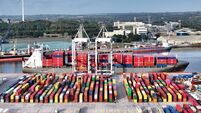'Challenging' first half sees 65% rise in Cork business insolvencies

Impacting prominent sectors including hospitality and construction, Cork was the worst affected by business closures. Pic: Larry Cummins
Insolvencies have risen by just under half in the first six months of 2023 against a backdrop of rising inflationary pressures and uncertainty, with the winding up of government pandemic supports also coinciding with an almost 50% increase.
Between January and June of this year, 410 insolvencies were reported nationwide, up from just 277 recorded in the same period last year, reflecting a 48% rise.
Latest figures from credit risk analyst, CRIFVision-Net show that Cork saw a dramatic surge in business closures, rising by 65% in the first half of this year, almost double the increase seen in Dublin which rose by just 35%.
The increase in business closures coincides with rising interest rates following eight consecutive hikes by the European Central Bank to curb inflation, with a number of 'zombie businesses' - those that could not be kept open without the help of government support - declaring insolvencies once they were removed.
Impacting prominent sectors including hospitality and construction, Cork was the worst affected by business closures, while Limerick recorded a more positive performance, experiencing a significant 43% decline in insolvencies over the same period.
Galway also recorded a notable fall, with just under 20% fewer insolvencies in the first half of this year than in 2022.
However, the first six months of 2023 also saw a 7% increase in company start-ups, with 20 counties recording year-on-year growth. Benefitting key economic centres including Dublin, Cork and Galway, more than 2,527 new start-ups were reported in May alone, with the period's quietest month seeing the opening of more than 1,700 new businesses.
Recording growth of 8% in the first half of this year, Galway saw the largest increase in start-up activity, with Dublin and Cork reporting growth of 7% and 5% respectively.
Despite seeing a 43% decline in business closures, Limerick saw the lowest level of new start-up activity, down 6%, and was the only large urban population to exhibit a decrease in new start-ups.
Bellwether sectors including hospitality, real estate, IT, financial services and construction all benefited from rising start-up activity, however, CRIFVision-Net notes that growth was recorded from "a relatively low baseline," in 2022.
Despite growth as high as 12% across some sectors, not all industries benefited from start-up activity, with manufacturing seeing a 9% decline in new businesses.
Commenting on the figures, Managing Director of CRIFVision-net, Christine Cullen noted that evaluating the data was by no means a "straightforward exercise," adding that, "at a global level, we continue to grapple with economic uncertainty, high interest rates, and a rising cost of living."
"Despite these macro-economic pressures, the Irish economy has proven resilient. Corporate tax receipts are up and the Irish Government finds itself trying to allocate an €8bn budget surplus. That said, the continued rise in insolvencies is a reminder that these headline numbers don’t tell the full story."
A collection of the latest business articles and business analysis from Cork.














